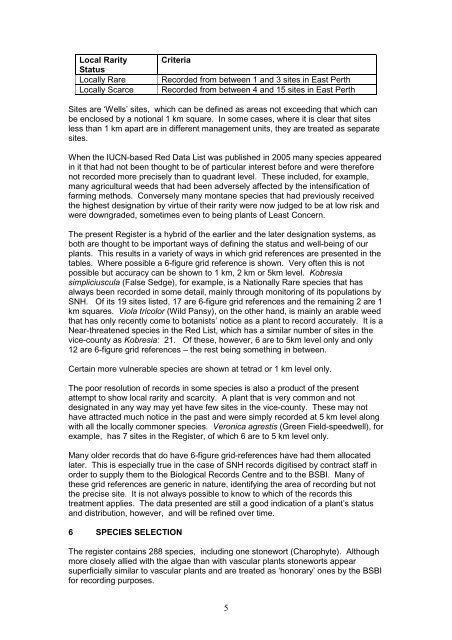East Perthshire - Botanical Society of the British Isles
East Perthshire - Botanical Society of the British Isles
East Perthshire - Botanical Society of the British Isles
Create successful ePaper yourself
Turn your PDF publications into a flip-book with our unique Google optimized e-Paper software.
Local Rarity<br />
Status<br />
Criteria<br />
Locally Rare Recorded from between 1 and 3 sites in <strong>East</strong> Perth<br />
Locally Scarce Recorded from between 4 and 15 sites in <strong>East</strong> Perth<br />
Sites are ‘Wells’ sites, which can be defined as areas not exceeding that which can<br />
be enclosed by a notional 1 km square. In some cases, where it is clear that sites<br />
less than 1 km apart are in different management units, <strong>the</strong>y are treated as separate<br />
sites.<br />
When <strong>the</strong> IUCN-based Red Data List was published in 2005 many species appeared<br />
in it that had not been thought to be <strong>of</strong> particular interest before and were <strong>the</strong>refore<br />
not recorded more precisely than to quadrant level. These included, for example,<br />
many agricultural weeds that had been adversely affected by <strong>the</strong> intensification <strong>of</strong><br />
farming methods. Conversely many montane species that had previously received<br />
<strong>the</strong> highest designation by virtue <strong>of</strong> <strong>the</strong>ir rarity were now judged to be at low risk and<br />
were downgraded, sometimes even to being plants <strong>of</strong> Least Concern.<br />
The present Register is a hybrid <strong>of</strong> <strong>the</strong> earlier and <strong>the</strong> later designation systems, as<br />
both are thought to be important ways <strong>of</strong> defining <strong>the</strong> status and well-being <strong>of</strong> our<br />
plants. This results in a variety <strong>of</strong> ways in which grid references are presented in <strong>the</strong><br />
tables. Where possible a 6-figure grid reference is shown. Very <strong>of</strong>ten this is not<br />
possible but accuracy can be shown to 1 km, 2 km or 5km level. Kobresia<br />
simpliciuscula (False Sedge), for example, is a Nationally Rare species that has<br />
always been recorded in some detail, mainly through monitoring <strong>of</strong> its populations by<br />
SNH. Of its 19 sites listed, 17 are 6-figure grid references and <strong>the</strong> remaining 2 are 1<br />
km squares. Viola tricolor (Wild Pansy), on <strong>the</strong> o<strong>the</strong>r hand, is mainly an arable weed<br />
that has only recently come to botanists’ notice as a plant to record accurately. It is a<br />
Near-threatened species in <strong>the</strong> Red List, which has a similar number <strong>of</strong> sites in <strong>the</strong><br />
vice-county as Kobresia: 21. Of <strong>the</strong>se, however, 6 are to 5km level only and only<br />
12 are 6-figure grid references – <strong>the</strong> rest being something in between.<br />
Certain more vulnerable species are shown at tetrad or 1 km level only.<br />
The poor resolution <strong>of</strong> records in some species is also a product <strong>of</strong> <strong>the</strong> present<br />
attempt to show local rarity and scarcity. A plant that is very common and not<br />
designated in any way may yet have few sites in <strong>the</strong> vice-county. These may not<br />
have attracted much notice in <strong>the</strong> past and were simply recorded at 5 km level along<br />
with all <strong>the</strong> locally commoner species. Veronica agrestis (Green Field-speedwell), for<br />
example, has 7 sites in <strong>the</strong> Register, <strong>of</strong> which 6 are to 5 km level only.<br />
Many older records that do have 6-figure grid-references have had <strong>the</strong>m allocated<br />
later. This is especially true in <strong>the</strong> case <strong>of</strong> SNH records digitised by contract staff in<br />
order to supply <strong>the</strong>m to <strong>the</strong> Biological Records Centre and to <strong>the</strong> BSBI. Many <strong>of</strong><br />
<strong>the</strong>se grid references are generic in nature, identifying <strong>the</strong> area <strong>of</strong> recording but not<br />
<strong>the</strong> precise site. It is not always possible to know to which <strong>of</strong> <strong>the</strong> records this<br />
treatment applies. The data presented are still a good indication <strong>of</strong> a plant’s status<br />
and distribution, however, and will be refined over time.<br />
6 SPECIES SELECTION<br />
The register contains 288 species, including one stonewort (Charophyte). Although<br />
more closely allied with <strong>the</strong> algae than with vascular plants stoneworts appear<br />
superficially similar to vascular plants and are treated as ‘honorary’ ones by <strong>the</strong> BSBI<br />
for recording purposes.<br />
5

















